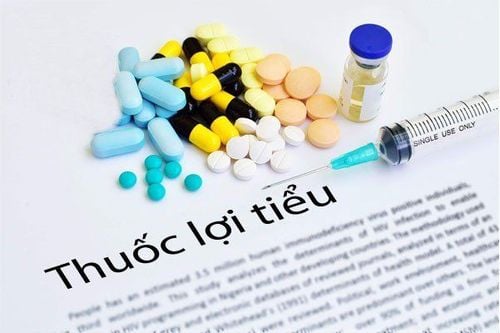This is an automatically translated article.
Tepirace is a drug belonging to the cardiovascular group, with the main ingredient being Clonidine hydrochloride 0.15 mg. The drug is used to lower blood pressure and effectively relieve severe sympathomimetic symptoms in heroin and nicotine withdrawal. For more information about Tepirace, you can refer to the following article.
1. What is Tepirace?
Contains the active ingredient is Clonidine hydrochloride, the effects of Tepirace in the treatment of cardiovascular disease such as lowering blood pressure, reducing symptoms of sympathomimetic are all thanks to the physiological mechanism of the main active ingredient.
Clonidine is a selective alpha 2-adrenergic receptor agonist located in the cardiovascular control center of the central nervous system. The drug causes hypotensive effects, changes in heart rate due to reduction of noradrenaline secretion in sympathetic nerves. Clonidine reduces blood levels of noradrenaline, renin and aldosterone levels in some patients with high blood pressure. In addition, clonidine also acts on alpha 2 receptors in the brain (at the nucleus and locus ceruleus), thereby reducing withdrawal symptoms that occur in patients who stop taking opiate hypnotics.
2. Indications and contraindications of Tepirace
2.1. Indications Tepirace is used in the following conditions:
Mild and moderate hypertensive disease, not the first priority group to lower blood pressure. A second-line drug effectively relieves severe sympathomimetic symptoms when patients are addicted to heroin or nicotine. Used in the diagnosis of hypertension caused by pheochromocytoma. After taking 0.3 mg of clonidine, but noradrenaline in the blood does not decrease, it is possible to diagnose a pheochromocytoma. 2.2. Contraindications Do not use Tepirace in the following cases:
Patients are allergic to clonidine, any of the excipients of the drug. Patients with sinus node failure.
3. Dosage and how to take Tepirace
How to use: Tepirace is taken orally, should take the tablet whole with a full glass of water.
Dosage:
Adults: Take 2 times a day, each time the starting dose is 0.1 mg. Oral maintenance dose 0.2 - 1.2 mg, divided into 2 - 4 times.
Maximum dose: 2.4 mg daily.
Elderly: Take 1 time a day starting dose of 0.1 mg at bedtime. The dose can be increased as needed.
Children under 12 years of age: The safety and effectiveness of Tepirace have not been established. In case of renal impairment: Initial dose is 50% - 75% of the normal dose when the patient's creatinine clearance is less than 10 ml/min. Symptomatic treatment when patients withdraw from opiates, nicotine: Take 2 times a day, 0.1 mg each time. The maximum daily dose is 0.4 mg for a period of 3-4 weeks. Note:
When it is necessary to stop drug treatment, the patient should be reduced the dose gradually over several days (about 3-5 days).
4. Undesirable effects when using Tepirace
Undesirable effects when using Tepirace, the most common are dry mouth and sedative effects (about 40%). There may be sexual dysfunction, marked bradycardia... These undesirable side effects are dose dependent.
Common: systemic signs such as somnolence, fatigue, gastrointestinal signs including nausea/vomiting, dry mouth. Uncommon: Central nervous system symptoms such as depression, gastrointestinal disturbances including diarrhea or constipation, skin rash. Rare: Impotence, orthostatic hypotension, central nervous system hallucinogens, intestinal obstruction, paralytic ileus, eye accommodation disorders... In case of rapid discontinuation of the drug, e.g. forgetting to take the drug, or stopping the drug. After long-term therapy withdrawal symptoms such as palpitations, agitation, restlessness may occur. Reversible hypertension may be experienced above baseline blood pressure prior to initiation of therapy.
How to handle when patients experience unwanted effects:
Need to carefully monitor: Blood pressure measured in positions: standing, sitting, supine, respiratory rate and depth, heart rate, decreasing grade pain, mental state. When undesirable side effects occur, the dose can be reduced. Patients should not stop taking Tepirace without their doctor's instructions. When stopping the drug, the dose must be gradually reduced within 2-4 days, in order to avoid rebound hypertension, during epidural injection, the patient should be carefully monitored the cardiovascular and respiratory status. Notify the doctor to treat the unwanted side effects that the patient experiences when using Tepirace.
5. Notes while using Tepirace
Notes while taking Tepirace include:
Tepirace should be used with caution in patients with cerebrovascular disease, coronary artery disease, kidney failure. In the treatment of hypertension, Tepirace can be used alone or in combination with other antihypertensive drugs. Tepirace should not be used as a first-line treatment for hypotension. Do not abruptly discontinue the drug, as blood pressure may rise rapidly and symptoms of sympathetic overactivity include tremor, increased heart rate, restlessness, agitation, insomnia, palpitations, perspire. Severe rebound hypertension may occur. If the drug must be discontinued, the dose should be tapered gradually over at least a week, adjusting the dose in patients with renal dysfunction, especially in the elderly. Tepirace should not be used for the relief of pain in obstetrics, postpartum or around the time of surgery, in hemodynamically unstable patients who cannot tolerate bradycardia and low blood pressure. When there are signs of drug overdose such as diarrhea, respiratory arrest, bradycardia, central nervous system depression...Patients should be treated with supportive care and symptomatic treatment such as intravenous fluids, placing the patient in hospital. In the Trendelenburg position, naloxone can be administered intravenously at a dose of 0.4 - 2 mg or by infusion. No risk of malformations has been observed with the use of Tepirace during pregnancy, however, this drug must be used with caution, as the side effect can cause severe rebound hypertension on abrupt discontinuation, which can affect blood flow to the placenta. The drug is excreted in milk, considering the case of mothers taking clonidine while breastfeeding, in fact, there has been a decrease in blood pressure in young children. The drug can cause drowsiness, impaired coordination and concentration, Tepirace should be used with caution when driving vehicles or patients needing to operate machinery. Drug interactions: When co-administering Tepirace with the following drugs, interactions may occur that affect the effectiveness of the drug.
Tricyclic antidepressants antagonize their antihypertensive effect, increasing the risk of a hypertensive response to abrupt discontinuation of Tepirace. Beta-blockers may increase the potential for bradycardia in people taking Tepirace and may pose a risk of severe rebound hypertension upon discontinuation of the drug. Beta-blockers should be discontinued for several days (7 to 10 days) before starting treatment with Tepirace. Tepirace may increase the effect of sedatives and alcohol. Tepirace drug has an ingredient of clonidine, used according to prescription, patients must not arbitrarily use the drug, increase the dose or stop the drug suddenly. The use of Tepirace drug needs to be specifically prescribed by a doctor. In case readers still have questions about Tepirace, please see pharmacists and specialist doctors for answers.













